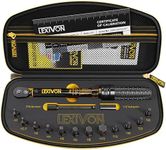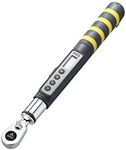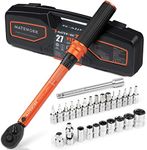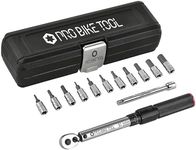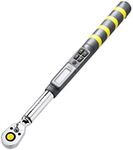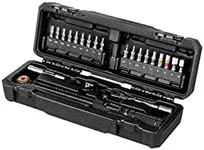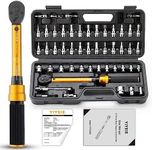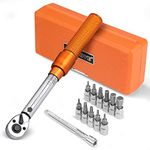Buying Guide for the Best Torque Wrench For Bicycle
Choosing the right torque wrench for your bicycle is important to ensure that bolts and components are tightened to the correct specifications, preventing damage and ensuring safety. A torque wrench helps you apply just the right amount of force, which is especially important for modern bikes with lightweight materials. When picking a torque wrench, consider how you'll use it, what parts you'll be working on, and how comfortable and easy it is to use.Torque RangeThe torque range tells you the minimum and maximum force the wrench can measure, usually in Newton-meters (Nm). This is important because different bike parts require different torque settings. For most bicycles, a range of about 2-20 Nm covers common needs like stems, seat posts, and handlebars. If you work on heavier parts or e-bikes, you might need a higher range. Choose a wrench with a range that matches the parts you'll be tightening most often, as using a wrench outside its ideal range can lead to inaccurate readings.
Type of Torque WrenchThere are a few main types: beam, click, and digital. Beam wrenches are simple and reliable but require you to watch a scale. Click wrenches make a 'click' sound when you reach the set torque, making them easy to use for beginners. Digital wrenches show the torque on a screen and sometimes beep or vibrate. If you want simplicity and reliability, a beam wrench is good. For ease and speed, a click or digital wrench is better. Think about how much feedback you want and how comfortable you are reading scales or using digital tools.
Drive SizeDrive size refers to the size of the square fitting where you attach sockets or bits, commonly 1/4-inch or 3/8-inch for bicycle work. A 1/4-inch drive is usually enough for most bike bolts and is lighter and easier to handle in tight spaces. If you plan to work on larger bolts or want more versatility, a 3/8-inch drive might be better. Match the drive size to the types of bolts and the space you have to work in on your bike.
AccuracyAccuracy is how close the wrench's reading is to the actual torque applied. This matters because over- or under-tightening can damage parts or make your bike unsafe. Most good torque wrenches are accurate to within ±4%. For most home mechanics, this is enough, but if you work on high-end bikes or carbon parts, look for higher accuracy. Always check if the wrench comes with a calibration certificate, which shows it has been tested for accuracy.
Ease of Use and ReadabilityHow easy it is to set and read the torque value affects your experience. Some wrenches have clear, easy-to-read scales or digital displays, while others can be harder to see, especially in low light. If you want a hassle-free experience, look for a wrench with a clear scale or display and simple adjustment. Consider how comfortable the handle feels and whether you can easily use it in the tight spaces on your bike.
Included Bits and AccessoriesMany torque wrenches come with a set of bits (like hex or Torx) and sometimes a storage case. This is important because bike bolts come in different shapes and sizes. If you want a ready-to-use kit, look for a wrench that includes the bits you need for your bike. If you already have a set of bits, you might not need extras. Think about what bolts you’ll be working on and whether the included accessories match your needs.
